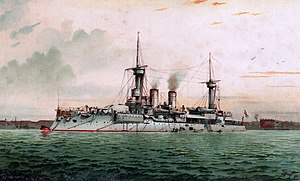Ottoman battleship Turgut Reis

Painting of Weissenburg in 1902
|
|
| History | |
|---|---|
|
|
|
| Name: | Weissenburg |
| Namesake: | Town of Weissenburg |
| Builder: | AG Vulcan Stettin |
| Laid down: | May 1890 |
| Launched: | 14 December 1891 |
| Commissioned: | 14 October 1894 |
| Fate: | Sold to the Ottoman Empire |
|
|
|
| Name: | Turgut Reis |
| Namesake: | Turgut Reis |
| Acquired: | 12 September 1910 |
| Fate: | Scrapped in 1957 |
| General characteristics | |
| Class and type: | Brandenburg-class battleship |
| Displacement: | 10,670 t (10,500 long tons) |
| Length: | 115.7 m (379 ft 7 in) |
| Beam: | 19.5 m (64 ft 0 in) |
| Draft: | 7.9 m (25 ft 11 in) |
| Installed power: | 10,000 PS (9,860 ihp; 7,350 kW) |
| Propulsion: | 2-shaft triple expansion engines |
| Speed: | 16.9 knots (31.3 km/h; 19.4 mph) |
| Range: | 4,300 nautical miles (8,000 km; 4,900 mi) at 10 knots (19 km/h; 12 mph) |
| Complement: |
|
| Armament: |
|
| Armor: | |
SMS Weissenburg was one of the first ocean-going battleships of the Imperial German Navy. She was the third pre-dreadnought of the Brandenburg class, along with her sister ships Brandenburg, Wörth, and Kurfürst Friedrich Wilhelm. She was laid down in 1890 in the AG Vulcan dockyard in Stettin, launched in 1891, and completed in 1894. The Brandenburg-class battleships were unique for their era in that they carried six large-caliber guns in three twin turrets, as opposed to four guns in two turrets, as was the standard in other navies. The British Royal Navy derisively referred to the ships as "whalers".
Weissenburg saw limited active duty during her service career with the German fleet. She, along with her three sisters, saw one major overseas deployment, to China in 1900–01, during the Boxer Rebellion. The ship underwent a major modernization in 1902–1904. In 1910, Weissenburg was sold to the Ottoman Empire and renamed Turgut Reis, after the famous 16th century Turkish admiral Turgut Reis. The ship saw heavy service during the Balkan Wars, primarily providing artillery support to Ottoman ground forces and taking part in two naval engagements with the Greek navy in December 1912 and January 1913. She was largely inactive during World War I, due in part to her slow speed. In 1924, Turgut Reis was used as a school ship, before eventually being scrapped in the mid-1950s.
Weissenburg was 115.7 m (379 ft 7 in) long overall, had a beam of 19.5 m (64 ft 0 in) which was increased to 19.74 m (64 ft 9 in) with the addition of torpedo nets, and had a draft of 7.6 m (24 ft 11 in) forward and 7.9 m (25 ft 11 in) aft. The ship displaced 10,013 t (9,855 long tons) at its designed weight, and up to 10,670 t (10,500 long tons) at full combat load. She was equipped with two sets of 3-cylinder triple-expansion steam engines that provided 10,228 metric horsepower (10,088 ihp; 7,523 kW) and a top speed of 16.9 knots (31.3 km/h; 19.4 mph); steam was provided by twelve coal-fired, transverse cylindrical water-tube boilers. Weissenburg had a cruising range of 4,300 nautical miles (8,000 km; 4,900 mi) at 10 knots (19 km/h; 12 mph). Her crew numbered 38 officers and 530 enlisted men.
...
Wikipedia
